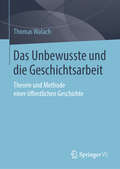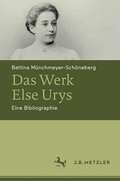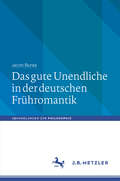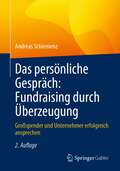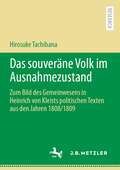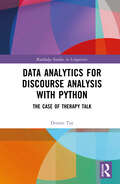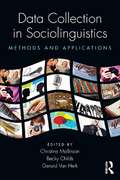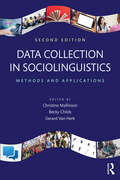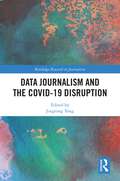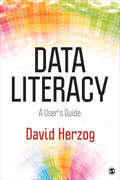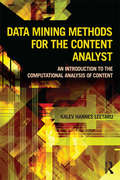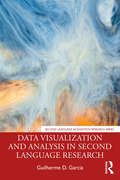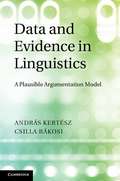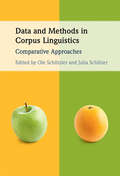- Table View
- List View
Das Unbewusste und die Geschichtsarbeit: Theorie und Methode einer öffentlichen Geschichte
by Thomas WalachDie Geschichtswissenschaft steckt in der Krise. Ist sie dabei, ihre Deutungshoheit über die Geschichte endgültig zu verlieren? Und was bedeutet das für die Zukunft der liberalen Demokratie, deren eigene Krise sich immer deutlicher abzeichnet? Zur Beantwortung dieser Fragen macht sich Thomas Walach auf die Suche nach dem Unbewussten in der Geschichte und den weitgehend unerforschten Wegen, die es mit politischer Identität und öffentlichen Geschichtsbildern verbinden. Will die Geschichtswissenschaft ihre Stimme im politischen Diskurs über Vergangenheit wiederfinden, muss sie lernen, sich mit dem historischen Unbewussten auseinanderzusetzen.Der InhaltPsychoanalyse und GeschichtswissenschaftDas historische UnbewussteDas kollektive Gedächtnis als politischer VergangenheitskonsensRevision und GeschichtsbewusstseinDie Geschichtsarbeit am WerkGesellschaft ohne GeschichteWir HistoristenWas tun? Plädoyer für eine Geschichte im Dienst der GegenwartGeschichtsarbeit als Methode der öffentlichen GeschichteNachwortDie ZielgruppenDozierende, Studierende und Praktiker aus den Fachbereichen der Geschichtswissenschaft Politikwissenschaften Soziologie Kulturwissenschaften Psychologie Bevölkerungswissenschaft Kulturwissenschaft Journalismus KommunikationswissenschaftDer AutorThomas Walach ist Universitätsassistent für die Geschichte der Neuzeit an der Universität Wien. Er lehrt und forscht zu Digitalisierung, Quellentheorie und dem Verhältnis von Geschichte und Öffentlichkeit.
Das Werk Else Urys: Eine Bibliographie
by Bettina Münchmeyer-SchönebergDie Bibliographie präsentiert erstmals in systematischer Weise Leben und Werk der bekannten jüdischen Jugendbuchautorin Else Ury (1877–1943), die vor allem durch ihre Nesthäkchen-Reihe große Popularität erlangte. Jedes Werk wird in seiner historischen und gegenwärtigen Bedeutung erläutert, es werden biographische Bezüge hergestellt, motivgeschichtliche Anmerkungen gegeben und interpretatorische Ansätze aufgezeigt. Die mehr als 1600 Einträge enthalten auch eine Reihe bisher unbekannter Erzählungen. Abbildungen im Online-Anhang erlauben die zweifelsfreie Identifizierung aller Werke. Die über zehn Register im Anhang erschlossene Arbeit bietet eine unentbehrliche Grundlage für die weitere Erforschung von Leben und Werk Else Urys.
Das ganze Leben – Repräsentationen von Arbeit in Texten über Kindheit und Jugend (Studien zu Kinder- und Jugendliteratur und -medien #12)
by Caroline Roeder Christine LötscherArbeit bedeutet im 21. Jahrhundert nicht (mehr) das sprichwörtliche ›halbe Leben‹, sondern erstreckt sich heute in zunehmender Entgrenzung auf alle Lebensbereiche. Der vorliegende Band umfasst 20 Beiträge und stellt die Untersuchung von Repräsentationen von Arbeit in Kindheit und Jugend erzählenden Texten sowie im Textkorpus der Kinder- und Jugendliteratur in den Mittelpunkt. Die historisch wie kulturwissenschaftlich ausgerichteten Ansätze eröffnen neue Blickwinkel; mediale wie populärkulturelle Fragestellungen erweisen sich als zentrale, weiterführende Arbeitsfelder.
Das gute Unendliche in der deutschen Frühromantik (Abhandlungen zur Philosophie)
by Jacob BurdaDas Buch eröffnet einen völlig anderen Blick auf die Romantik: Anstelle von Nostalgie, unendlicher und unerfüllter Annäherung steht das Harmonische und Versöhnliche im Mittelpunkt. Jacob Burda vertritt die in der Forschungsliteratur neue These, dass die Figur der guten Unendlichkeit schon der Frühromantik zuzuordnen ist - und nicht erst mit G.W.F. Hegel beginnt. Das hat weitreichende Konsequenzen für die Ästhetik, die Theologie und das Kunstverständnis, das wir gemeinhin mit der Romantik assoziieren. – Mit einem Geleitwort von Bazon Brock und einer Replik von Manfred Frank.
Das persönliche Gespräch: Großspender und Unternehmer erfolgreich ansprechen
by Andreas SchiemenzGroßspenden und Unternehmensspenden stellen einen der wichtigsten Erfolgsfaktoren im Fundraising dar und erfordern bei der Akquise besondere Herangehensweisen. Nur mit einer gezielten und persönlichen Ansprache lassen sich Großspender und Unternehmer als Unterstützer gewinnen. Schritt für Schritt erläutert Andreas Schiemenz - selbst mit langjähriger Erfahrung im Bereich des Fundraising für Großspender und Unternehmen in verschiedenen Non-Profit-Organisationen - wie Sie die richtigen Ansprechpartner finden und auswählen, eine individuelle Kommunikationsstrategie entwickeln, Gespräche mit potenziellen Spendern effizient nachbereiten und wie Sie Geber zu langfristigen Spendern machen. Dabei werden sowohl die strukturellen Prozesse bei der Tätigkeit von Spendenorganisationen beleuchtet als auch die praktische Umsetzung anhand zahlreicher Praxisbeispiele vorgestellt. ,,Fundraising macht Menschen glücklich" - die Geber, die Spendensammler und die Menschen, denen mit den finanzierten Projekten geholfen werden kann.
Das persönliche Gespräch: Großspender und Unternehmer erfolgreich ansprechen
by Andreas SchiemenzGroßspenden und Unternehmensspenden stellen einen der wichtigsten Erfolgsfaktoren im Fundraising dar und erfordern bei der Akquise besondere Herangehensweisen. Nur mit einer gezielten und persönlichen Ansprache lassen sich Großspender und Unternehmer als Unterstützer gewinnen. Schritt für Schritt erläutert Andreas Schiemenz – selbst mit langjähriger Erfahrung im Bereich des Fundraising für Großspender und Unternehmen in verschiedenen Non-Profit-Organisationen – wie Sie die richtigen Ansprechpartner finden und auswählen, eine individuelle Kommunikationsstrategie entwickeln, Gespräche mit potenziellen Spendern effizient nachbereiten und wie Sie Geber zu langfristigen Spendern machen. Dabei werden sowohl die strukturellen Prozesse bei der Tätigkeit von Spendenorganisationen beleuchtet als auch die praktische Umsetzung anhand zahlreicher Praxisbeispiele vorgestellt. „Fundraising macht Menschen glücklich“ – die Geber, die Spendensammler und die Menschen, denen mit den finanzierten Projekten geholfen werden kann.Die zweite Auflage wurde aktualisiert, um neue Gesprächsbeispiele und ein weiteres Kapitel ergänzt.
Das philosophische Potenzial von Fabeln: Systematische und praxisorientierte Untersuchungen zum Einsatz von Fabeln im Philosophieunterricht der Sekundarstufe I (Philosophische Bildung in Schule und Hochschule)
by Esther SeibertDas vorliegende Open-Access-Buch zeigt, wie Fabeln im Philosophieunterricht der Sekundarstufe I eingesetzt werden können, um philosophische Gedanken bei Kindern und Jugendlichen anzustoßen. Dabei werden zunächst Kriterien für die Auswahl geeigneter Fabeln vorgestellt, wobei insbesondere die vermeintliche Lehre der Fabel in den Hintergrund rückt. Eine umfangreiche Katalogisierung von Fabeln nach philosophischen Themenbereichen kann Lehrkräften Entlastung bei der Auswahl geeigneter Fabeln bieten. Ein Vorschlag zum Umgang mit Fabeln im Philosophieunterricht schließt sich an. Die aus unterrichtlichen Erprobungen gezogenen Erkenntnisse zeigen: Wenn Fabeln nicht mit Blick auf ihre Lehre im Unterricht eingesetzt werden, werden Schüler*innen zur Formulierung differenzierter philosophischer Gedanken angeregt, die anhand der Fabel systematisch vertieft und reflektiert werden können.
Das souveräne Volk im Ausnahmezustand: Zum Bild des Gemeinwesens in Heinrich von Kleists politischen Texten aus den Jahren 1808/1809
by Hirosuke TachibanaHeinrich von Kleists politische Texte aus den Jahren 1808/1809 werden in der Forschung oft als Ausdruck des bedenklichen Nationalismus gelesen, der an den rassistischen Chauvinismus angrenze. Die vorliegende Arbeit untersucht dieses kontrovers diskutierte Problem aus der staatsrechtlichen Perspektive und zeigt, dass es hier um eine implizite politische Theorie des Dichters geht, die mit dem auf die römische Antike zurückreichenden verfassungsrechtlichen Begriff des Ausnahmezustandes untrennbar verknüpft ist. Mit der Krisensituation in Zusammenhang gebracht, treten der Staat und die Nation bei Kleist als instabile und dynamische Existenzen auf und gerade in diesem Punkt kann man eine Radikalisierung des Konzeptes der Volkssouveränität feststellen, mit dem die französischen Revolutionäre und Rousseau ihren Republikanismus begründen; das also mit dem Rassismus nichts zu tun hat.
Das vergessene Subjekt: Subjektkonstitutionen in mediatisierten Alltagswelten (Medien • Kultur • Kommunikation)
by Jeffrey Wimmer Friedrich Krotz Rainer Winter Peter GentzelDer Band liefert eine kritische Bestandsaufnahme bestehender Subjektkonzeptionen der kommunikationswissenschaftlichen Forschung. Zudem werden Konzepte entwickelt um Subjektivität im Kontext aktueller theoretischer Debatten (u.a. Mediensoziologie, Cultural Studies, Psychoanalyse, Praxistheorie, Science and Technology Studies) sowie sozialer, kultureller und technischer Entwicklungen (u.a. Digitalisierung, Mediatisierung, Mobilität und Vernetzung) analysieren zu können. Da Subjektkonzeptionen für jegliche Kommunikations- und Medienanalysen von zentraler Bedeutung sind, schließt der Band eine zentrale Leerstelle der Kommunikations- und Medienwissenschaft.
Data + Journalism: A Story-Driven Approach to Learning Data Reporting
by Mike Reilley Samantha SunneTaking a hands-on and holistic approach to data, Data + Journalism provides a complete guide to reporting data-driven stories. This book offers insights into data journalism from a global perspective, including datasets and interviews with data journalists from countries around the world. Emphasized by examples drawn from frequently updated sets of open data posted by authoritative sources like the FBI, Eurostat and the US Census Bureau, the authors take a deep dive into data journalism’s "heavy lifting" – searching for, scraping and cleaning data. Combined with exercises, video training supplements and lists of tools and resources at the end of each chapter, readers will learn not just how to crunch numbers but also how to put a human face to data, resulting in compelling, story-driven news stories based on solid analysis. Written by two experienced journalists and data journalism teachers, Data + Journalism is essential reading for students, instructors and early career professionals seeking a comprehensive introduction to data journalism skills.
Data Analytics for Discourse Analysis with Python: The Case of Therapy Talk (Routledge Studies in Linguistics)
by Dennis TayThis concise volume, using examples of psychotherapy talk, showcases the potential applications of data analytics for advancing discourse research and other related disciplines.The book provides a brief primer on data analytics, defined as the science of analyzing raw data to reveal new insights and support decision making. Currently underutilized in discourse research, Tay draws on the case of psychotherapy talk, in which clients’ concerns are worked through via verbal interaction with therapists, to demonstrate how data analytics can address both practical and theoretical concerns. Each chapter follows a consistent structure, offering a streamlined walkthrough of a key technique, an example case study, and annotated Python code. The volume shows how techniques such as simulations, classification, clustering, and time series analysis can address such issues as incomplete data transcripts, therapist–client (a)synchrony, and client prognosis, offering inspiration for research, training, and practitioner self-reflection in psychotherapy and other discourse contexts.This volume is a valuable resource for discourse and linguistics researchers, particularly for those interested in complementary approaches to qualitative methods, as well as active practitioners.
Data Collection in Sociolinguistics: Methods and Applications
by Gerard Van Herk Christine Mallinson Becky ChildsThis edited volume provides up-to-date, succinct, relevant, and informative discussion about methods of data collection in sociolinguistic research. It covers the main areas of research design, conducting research, and sharing data findings with longer chapters and shorter vignettes written by a range of top sociolinguists, both veteran and emerging scholars. Here is the one-stop, go-to guide for the numerous quantitative, qualitative, and mixed methods that are used in sociolinguistic research, ensuring that Data Collection in Sociolinguistics will be not only useful in the classroom but also as a reference tool for active researchers. For more information, visit sociolinguisticdatacollection.com.
Data Collection in Sociolinguistics: Methods and Applications, Second Edition
by Gerard Van Herk Christine Mallinson Becky ChildsThe second edition of Data Collection in Sociolinguistics: Methods and Applications continues to provide up-to-date, succinct, relevant, and informative discussion about methods of data collection in sociolinguistic research. Written by a range of top sociolinguists, both veteran and emerging scholars, it covers the main areas of research design, conducting research, and sharing data findings. In addition to revisions of original material, this edition includes nine new vignettes covering such topics as collecting data from social media, conducting linguistic landscape research, forensic linguistic data collection, and working with transgender communities. A companion website, http://sociolinguisticdatacollection.com, provides enhanced pedagogical features such as discussion questions, activities, end-of-chapter exercises, and contributor videos. This volume is the one-stop, go-to guide for the numerous quantitative, qualitative, and mixed methods used in sociolinguistic research; it is the ideal resource for undergraduate and graduate courses in sociolinguistic research, field methods and data collection.
Data Elicitation for Second and Foreign Language Research (Second Language Acquisition Research Ser.)
by Alison Mackey Susan M. GassThis timely reference guide is specifically directed toward the needs of second language researchers, who can expect to gain a clearer understanding of which techniques may be most appropriate and fruitful in given research domains. Data Elicitation for Second and Foreign Language Research is a perfect companion to the same author team‘s bestsellin
Data Journalism and the COVID-19 Disruption (Routledge Research in Journalism)
by Jingrong TongData Journalism and the COVID‑19 Disruption offers an international, multidisciplinary account of how and to what extent the COVID‑19 pandemic has been a blessing for data journalism.Bringing together insights into current developments in data journalism during (and since the onset of) the COVID‑19 pandemic from world‑leading data journalism practitioners and academics, this book draws on case studies and examples from different countries to critically reflect on emerging data journalism practices during the pandemic and their sustainability and implications for journalism and newsroom work in the post‑pandemic era. The chapters document changes in the practice and integration of data journalism into newsrooms and the 24/7 news cycle after the unexpected onset of the pandemic and explore how newsrooms and journalists are coping with the sudden and immense demand for data journalism and related challenges. This book also scrutinises the implications for understanding the roles played by newsroom structure and operation, the uncertain nature of data, and the relationship between journalism and other social entities such as audiences and the state in journalism’s development through times of crisis.Offering a timely contribution to the discussions on how data journalism evolved during a time of crisis, this volume will appeal to scholars and students of data journalism, journalism practice, media and communication studies, and media industry studies.
Data Journalism in the Global South (Palgrave Studies in Journalism and the Global South)
by Saba Bebawi Bruce Mutsvairo Eddy Borges-ReyThis volume seeks to analyse the emerging wave of data journalism in the Global South. It does so by examining trends, developments and opportunities for data journalism in the aforementioned contexts. Whilst studies in this specific form of journalism are increasing in numbers and significance, there remains a dearth of literature on data journalism in less developed regions of the world. By demonstrating an interest in data journalism across countries including Chile, Argentina, the Philippines, South Africa and Iran, among others, this volume contributes to multifaceted transnational debates on journalism, and is a crucial reference text for anyone interested in data journalism in the ‘developing’ world. Drawing on a range of voices from different fields and nations, sharing empirical and theoretical experiences, the volume aims to initiate a global dialogue among journalism practitioners, researchers and students.
Data Literacy: A User′s Guide
by David L. HerzogA practical, skill-based introduction to data analysis and literacy We are swimming in a world of data, and this handy guide will keep you afloat while you learn to make sense of it all. In Data Literacy: A User′s Guide, David Herzog, a journalist with a decade of experience using data analysis to transform information into captivating storytelling, introduces students and professionals to the fundamentals of data literacy, a key skill in today’s world. Assuming the reader has no advanced knowledge of data analysis or statistics, this book shows how to create insight from publicly-available data through exercises using simple Excel functions. Extensively illustrated, step-by-step instructions within a concise, yet comprehensive, reference will help readers identify, obtain, evaluate, clean, analyze and visualize data. A concluding chapter introduces more sophisticated data analysis methods and tools including database managers such as Microsoft Access and MySQL and standalone statistical programs such as SPSS, SAS and R.
Data Literacy: A User′s Guide
by David L. HerzogA practical, skill-based introduction to data analysis and literacy We are swimming in a world of data, and this handy guide will keep you afloat while you learn to make sense of it all. In Data Literacy: A User′s Guide, David Herzog, a journalist with a decade of experience using data analysis to transform information into captivating storytelling, introduces students and professionals to the fundamentals of data literacy, a key skill in today’s world. Assuming the reader has no advanced knowledge of data analysis or statistics, this book shows how to create insight from publicly-available data through exercises using simple Excel functions. Extensively illustrated, step-by-step instructions within a concise, yet comprehensive, reference will help readers identify, obtain, evaluate, clean, analyze and visualize data. A concluding chapter introduces more sophisticated data analysis methods and tools including database managers such as Microsoft Access and MySQL and standalone statistical programs such as SPSS, SAS and R.
Data Mining Methods for the Content Analyst: An Introduction to the Computational Analysis of Content (Routledge Communication Series)
by Kalev LeetaruWith continuous advancements and an increase in user popularity, data mining technologies serve as an invaluable resource for researchers across a wide range of disciplines in the humanities and social sciences. In this comprehensive guide, author and research scientist Kalev Leetaru introduces the approaches, strategies, and methodologies of current data mining techniques, offering insights for new and experienced users alike. Designed as an instructive reference to computer-based analysis approaches, each chapter of this resource explains a set of core concepts and analytical data mining strategies, along with detailed examples and steps relating to current data mining practices. Every technique is considered with regard to context, theory of operation and methodological concerns, and focuses on the capabilities and strengths relating to these technologies. In addressing critical methodologies and approaches to automated analytical techniques, this work provides an essential overview to a broad innovative field.
Data Visualization and Analysis in Second Language Research (Second Language Acquisition Research Series)
by Guilherme D. GarciaThis introduction to visualization techniques and statistical models for second language research focuses on three types of data (continuous, binary, and scalar), helping readers to understand regression models fully and to apply them in their work. Garcia offers advanced coverage of Bayesian analysis, simulated data, exercises, implementable script code, and practical guidance on the latest R software packages. The book, also demonstrating the benefits to the L2 field of this type of statistical work, is a resource for graduate students and researchers in second language acquisition, applied linguistics, and corpus linguistics who are interested in quantitative data analysis.
Data Visualization in Enlightenment Literature and Culture
by Ileana BairdData Visualization in Enlightenment Literature and Culture explores the new interpretive possibilities offered by using data visualization in eighteenth-century studies. Such visualizations include tabulations, charts, k-means clustering, topic modeling, network graphs, data mapping, and/or other illustrations of patterns of social or intellectual exchange. The contributions to this collection present groundbreaking research of texts and/or cultural trends emerging from data mined from existing databases and other aggregates of sources. Describing both small and large digital projects by scholars in visual arts, history, musicology, and literary studies, this collection addresses the benefits and challenges of employing digital tools, as well as their potential use in the classroom.Chapters 1, 3, 8 and 10 are available open access under a Creative Commons Attribution 4.0 International License via link.springer.com.
Data and Evidence in Linguistics
by András Kertész Csilla RákosiThe question of what types of data and evidence can be used is one of the most important topics in linguistics. This book is the first to comprehensively present the methodological problems associated with linguistic data and evidence. Its originality is twofold. First, the authors' approach accounts for a series of unexplained characteristics of linguistic theorising: the uncertainty and diversity of data, the role of evidence in the evaluation of hypotheses, the problem solving strategies as well as the emergence and resolution of inconsistencies. Second, the findings are obtained by the application of a new model of plausible argumentation which is also of relevance from a general argumentation theoretical point of view. All concepts and theses are systematically introduced and illustrated by a number of examples from different linguistic theories, and a detailed case-study section shows how the proposed model can be applied to specific linguistic problems.
Data and Methods in Corpus Linguistics: Comparative Approaches
by Julia Schlüter Ole SchützlerCorpus linguistics continues to be a vibrant methodology applied across highly diverse fields of research in the language sciences. With the current steep rise in corpus sizes, computational power, statistical literacy and multi-purpose software tools, and inspired by neighbouring disciplines, approaches have diversified to an extent that calls for an intensification of the accompanying critical debate. Bringing together a team of leading experts, this book follows a unique design, comparing advanced methods and approaches current in corpus linguistics, to stimulate reflective evaluation and discussion. Each chapter explores the strengths and weaknesses of different datasets and techniques, presenting a case study and allowing readers to gauge methodological options in practice. Contributions also provide suggestions for further reading, and data and analysis scripts are included in an online appendix. This is an important and timely volume, and will be essential reading for any linguist interested in corpus-linguistic approaches to variation and change.
Data and Narrative in News Media: The Science of Communicating Evidence (Routledge Focus on Journalism Studies)
by Hai L. TranBringing together research from across media and psychology disciplines, this book provides an understanding of the impact of using qualitative and quantitative forms of evidence in the news.Drawing on previous studies with seemingly contradictory conclusions, the author proposes an integrative framework that explains the differential roles of data and narrative in evidence-based communication, as well as the potential for their combination. Bridging theory and practice, this book delves into the specific conditions and key factors influencing information processing, combining interdisciplinary scholarship from fields of media effects, persuasion, and cognitive psychology. It emphasizes the importance of incorporating numerical and story elements into journalism through scientific methods, underlining the effects on audience responses according to cognitive-experiential theory. Written accessibly and weaving in contemporary examples and data from around the world, this book expands our understanding of why certain qualitative and quantitative forms of evidence turn out to be (in)effective, translating these findings into take-away lessons to inform more thoughtful news writing and production.Data and Narrative in News Media is a versatile resource for researchers and scholars with an interest in media effects and the presentation of news.
Data for Journalism: Between Transparency and Accountability (Disruptions)
by Jingrong TongConsidering the interactions between developments in open data and data journalism, Data for Journalism: Between Transparency and Accountability offers an interdisciplinary account of this complex and uncertain relationship in a context of tightening the control over data and weighing transparency against privacy. As data has brought both promise and disruptive changes to societies, the relationship between transparency and accountability has become complicated, and data journalism is practised alongside the contradictory needs of opening up and protecting data. In addition to exploring the benefits of data for journalism, this book addresses the uncertain nature of data and the obstacles preventing data from being fluently accessed and properly used for data reporting. Because of these obstacles, it argues individual data journalists play a decisive role in using data for journalism and facilitating the circulation of data. Frictions in data access, newsrooms’ resources and cultures and data journalists’ skill and data literacy levels determine the degree to which journalism can benefit from data, and these factors potentially exacerbate digital inequalities between newsrooms in different countries and with different resources. As such, the author takes an international perspective, drawing on empirical research and cases from around the world, including countries such as the UK, the US, Germany, Sweden, Australia, India, China and Japan. Introducing a new dimension to the study of developments in journalism and the role of journalism in society, Data for Journalism will be of interest to academics and researchers in the fields of journalism and the sociology of (big and open) data.
